As the earth circles the sun our seasons change. In our controlled environments it’s possible to never notice. Many of us live with little contact with the living presence of earth, and have spent maybe five minutes of our life thinking about our ally, Pan, the “oldest, old thing”. Let’s open those doors to the Place where we live.
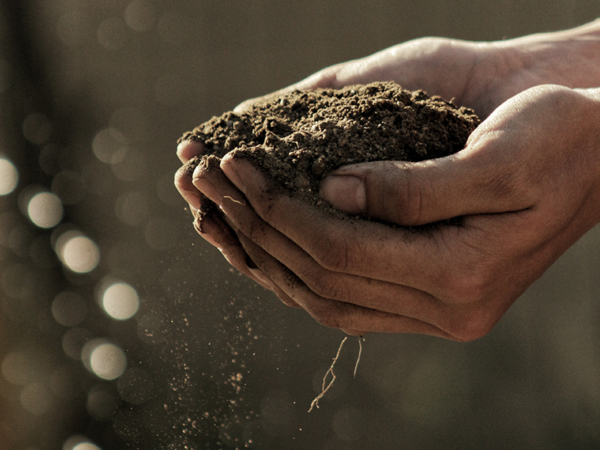
Photo Credit: Gabriel Jimenez, Unsplash
I want to share two readers’ comments because of their specific relationship to fire in their Place in the world. Then we’ll open August’s Lughnasadh, and explore the element Earth, and the “oldest old thing”: Pan. As we pass through this year’s Cross Quarters I am putting an emphasis on the four primal elements: Earth, Air (Samhain), Water (Imbolc), circling back to Fire (Beltaine). The solar celebrations continue to explore kinds of Time.
Comment #1: re: the May Day/Beltaine exploration of Fire, especially its Constructive and Destructive faces.
Wow Wow Wow! I just finished reading this and need to read it again…and again. I want to let you know about my experience with fire. I began associating it with special times because (when a child) we had a wood fire in our green marble fireplace when guests came to visit or on Holidays. I sat curled up on the carpeting in front of it with my Coca-Cola + lots of ice cubes in a gilded “highball” glass, and the grownups sat around the living room before dinner with their cocktails, amiably chatting away.… And whenever I was looking for a place to live, my criteria were that I could see a tree out of a window from my bed and would have a wood-burning fireplace.
I was amazingly successful with the latter. Then, one year when living in San Francisco, I came upon an entire City block engulfed in fire. The roar…the heat…the mass destruction! This was my first realization about the duality you mention. Still fire managed to evoke a warmth in me, up until the devastating Louisville fire this past New Years. I have thought to light the fire in my living room from time-to-time since then, but have not managed to do it. I find myself feeling more fear than warmth. … I do hope we can all make our way to a “constructive” perspective…
Comment #2: to the Summer Solstice exploration of Present Time: Just Be Now.
When my house burned in the Marshall Fire, it seemed everything was chaotic. There were so many details, from dealing with insurance to remembering the treasures in my house, sifting through the ash to reclaim any little thing, dealing with the loss and grief. But as time passed, I’ve added in more time to just be… still. It’s a challenge at times. There are still so many details from clearing the land to working with an architect to meeting with the builder. Plus, my … work. But I have the opportunity to start from Ground Zero – not many people can say that – and what a perfect time to work in time to just Be.
Both comments are generated by experiences with the primal element of Fire as related to each individual’s Place in the world – their home – and the healing necessity of being in Present Time – Right Now.
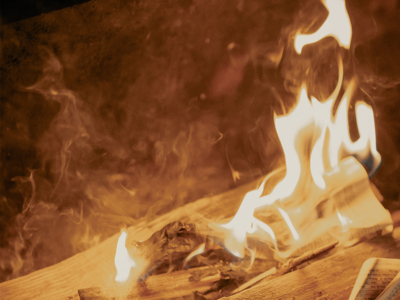
Fire, Photo Credit: Clay Banks, Unsplash
Lughnasadh – Earth Element
Following Summer Solstice our planet’s northern hemisphere moves into August, which begins the months of Harvest. Last year I introduced Lughnasadh as a reflection on Linear Time, based in the linearity of the agricultural year: seed, sprout, leaves, stem, flower, fruit. It becomes a circle only when you take a seed from the fruit. Harvest fulfills that linear earthly process, pointing out a relationship between all that is and Earth, our island home.
Harvest activities celebrate Place. If you are haying, there is only you, the weather, the machine you use, the smells of cut hay and your sweat. You don’t have time or energy to think about your or the world’s troubles. Roundup and driving the herd down mountain is the same. In my city garden I watch the weather closely, letting the plants stay in the ground and fruit as long as the earth stays warm. The trees turn, leaves fall. I walk a lot, and crunch the leaves on lawns if the owners have swept their sidewalks. I’ll lie under a tree, jacket-protected, and let the leaves fall on my face, blue sky above. (Fall leaves are a more firm experience than feather light spring blossoms.)
Puck – the “oldest, old thing”

Rudyard Kipling, New York Public Library Digital Collection
I first learned about the earth god Puck in Rudyard Kipling’s important book Puck of Pook’s Hill. If your only experience of the first English-language Noble Prize winner for Literature is Kipling’s excellent Jungle Book or Just So Stories, I suggest expanding your knowledge of the man and his work: Wikipedia offers a good accounting here.
Puck of Pook’s Hill is a fantasia wherein Puck leads two marvelous children through a weaving of short stories about historical events in England. Kipling’s characterization of Puck does not diminish the great god Pan but makes him less fearful. He tells the children he is the “oldest, old thing,” here from the very beginning.
Puck is Pan, a cloven-hoofed part goat, part human god, who lives in woodlands and meadows. The cloven hoof makes him a candidate for being a devil in some eras. Cloven hoofs (buffalo have them) dig in the earth, aerating it, and making it possible for seeds to easily sprout. The source of our word panic is Pan’s great shout that causes enemies to flee. Pan is a satyr, a faun, at ease with sexuality. He plays “Pan pipes”: here is a video illustrating this most lyrical instrument. I think the five minutes worth it even though it is an advertisement.
Death of Pan
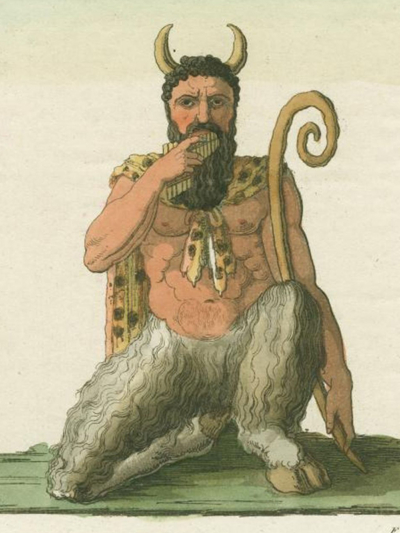 The Greek historian Plutarch (1st century AD) records a legend of a sailor (Thamus) hearing a voice calling across the water “The Great God Pan is Dead.” Centuries of discussion of the meaning of it won’t register my own opinion, but I offer that what died was a consciousness of intimate union with earth.
The Greek historian Plutarch (1st century AD) records a legend of a sailor (Thamus) hearing a voice calling across the water “The Great God Pan is Dead.” Centuries of discussion of the meaning of it won’t register my own opinion, but I offer that what died was a consciousness of intimate union with earth.
C.S. Lewis created Mr. Tumnus, a faun, as a character in the Narnia series. Fauns are enemies of the White Witch (she who freezes earth). Lewis also penned a poem called Pan’s Purge; here’s the first stanza:
I dreamt that all the planning of peremptory humanity
Had crushed Nature finally beneath the foot of Man;
Birth-control and merriment, Earth completely sterilized,
Bungalow and fun-fair, had fulfilled our Plan;
But the lion and the unicorn were sighing at the funeral,
Crying at the funeral
Sobbing at the funeral of the god Pan.
It ends with a purge of civilization and a new world begun: “Flowered turf had swallowed up the towered cities….”
I believe we cast ourselves out of Eden, separating ourselves, ceasing to be part of the core, becoming separate from, the rest of creation. Pan’s pipe calls us to move back into relationship with Place, to be aware of our revolution at waking and fading light, to use our perfectly shaped hands to hold earth, our use our nose to smell those dark, fertile odors. We are created part of our planet; all else is illusion.

Nils Peterson, Portrait by Judith Peterson
Nils Peterson on Pan (Thursday, June 9, 2022)
I am full of thanksgiving to be counted a friend of Nils Peterson. Here is his gift of his reflections on Pan, written on June 9, 2022.
I miss the old gods, the energies
that gathered where roads crossed,
the rocks that comforted or awed, trees
that hummed as you passed. No, not bees.
Once the cry “Great Pan is dead”
echoed throughout the world. So
we closed our eyes and shut our ears.
Yet, Is there a place where they gather?
A Valhalla – not filled with berserker Swedes –
where the quiet ones can remember
what it meant to be worshipped?
and what it meant to the worshippers.
When we decided there was just One and and he was a He and He lived in the Heavens far far above, we lost all of the small earth gods that had made us understand that all is sacred, the small Mercuries at each crossroad, the Quicksilvers, – the father tree in the forest, the nymph-spirit of the river from which we drank, the earthly presence of moonlight visiting to silver the garden. We knew there were bigger gods – Pan, All, All Earthly Things. Yet, according to Plutarch, in 14 BC, a sailor heard a divine voice cry, “Great Pan is dead.” Was that divine the voice of Pan’s lover? MiLady Allearth lamenting? Is that why we feel sometimes we have no one to talk to?
Pan-icky Thoughts – Nils Peterson Continues
I think what I was getting at the other day in my lamenting the loss of the small gods was a loss of the feeling of the sacred. In my thinking awe and sacred are kin. Fear is there too and All. I’ll get back to this in a round-about way.
More than 70 years ago I read a story about Pan, I don’t remember the name of it or the author but the theory behind it was that the gods became mortal when nobody believed in them anymore. Well, there came a time when the last believer in Pan died the god became human and had find ways of surviving. Well, first there was the matter of his hairy legs and hoofed feet. Pants took care of the former and I don’t recall how he found shoes that would work. (The cloven hoof was one sign of the devil in some visualizations.) Now, of course, he had to earn a living. Well, as you know from many of his pictures, he was a musician in his godly life and so he hooked up with a jazz band. I don’t remember if he switched to clarinet or played his hot licks on a flute or pan pipes.
When giving permission to use these reflections in this blog, Nils’ email text included the ee cummings poem about mud-luscious spring, childhood, and the goat-footed balloonMan. If you haven’t read this poem recently (or ever) here’s a link.
Nils on Pan in Kenneth Graham’s Wind in the Willows
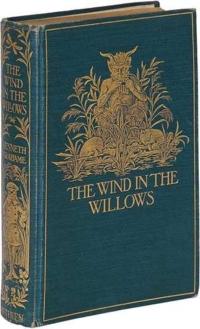 And here’s another story. In The Wind and the Willows, little Portly Otter goes missing, so Mole and Ratty join in the search party. At the end of a fruitless day of looking, they get in their boat and scull their way upstream. At first the moon lights up their search, “doing what she could, though so far off to help them in their quest.” She has to leave and day comes slowly and Ratty for a moment hears music, “So beautiful and strange and new!” Then he hears it again. Mole doesn’t hear it, so Rat tries to describe it, “The merry bubble and joy, the thin, clear, happy call … Such music I never dreamed of… Mole , Row! for the music and the call must be for us.” They land their boat, follow the music, at last Rat says “This is the place of my song-dream.”
And here’s another story. In The Wind and the Willows, little Portly Otter goes missing, so Mole and Ratty join in the search party. At the end of a fruitless day of looking, they get in their boat and scull their way upstream. At first the moon lights up their search, “doing what she could, though so far off to help them in their quest.” She has to leave and day comes slowly and Ratty for a moment hears music, “So beautiful and strange and new!” Then he hears it again. Mole doesn’t hear it, so Rat tries to describe it, “The merry bubble and joy, the thin, clear, happy call … Such music I never dreamed of… Mole , Row! for the music and the call must be for us.” They land their boat, follow the music, at last Rat says “This is the place of my song-dream.”
“Then suddenly the Mole felt a great awe fall upon him…he knew it could only mean that some august Presence was very, very near.” He is called against his will to look and he “saw the backward sweep of the curved horns…saw the stern, hooked nose between the kindly eyes…saw the long supple hand still holding the panpipes…saw the splendid curves of the shaggy limbs…last of all, nestling between his very hooves… the little, round, podgy, childish form of the baby otter.”
“Rat!…Are you afraid?”
“Afraid! Of Him? O, never, never! And yet-and yet, O Mole, I am afraid!”
Then the vision fades, then fades from their memory like a dream so beautiful that as Caliban said, “that when I waked, I cried to dream again.”
So, Awe, Sacred, Fear live together in this book … as they live together in the best fairy tales.
Nils continues:
Well, I guess Pan may have to give up his gig because I find myself a believer, a believer in that the goat-footed balloon man is calling us into the world of ongoing awe-filled, awe-full, sacred life. Yet, He is not one of the small gods that began my lament. I still want back the gods of rock, tree, and crossroad, the awe for the world that comes with our sense of the sacredness of place. I end with a poem of mine.
Where Here Is
How will we know where here is until it tells us,
until this oak speaks its story and these grasses
whisper what they learned as seedlings?
The crow overhead speaks with the caw of its own life.
The air about us carries smell messages from this place.
Knowing where here is, is paying with attention, not planting
a heavy foot on the shore of the earth
like a conquistador.
A small P.S. – I love the word podgy used to describe Portly at the feet of Pan.
Thank you to Nils Peterson.
Lughnasadh Calls us to Inhabit the Place where we Live
This blog is not an invitation to worship Pan, but to enter into an understanding that everything is alive, and we are alive as part of it, not separate from it. Every moment we are present and aware of our earth heals us both. In this season of Harvest be aware of the tang of the apple, the pattern of color on the leaf. Let us live in, be in attunement with, the place where we are. This is our task, every day, but especially at Lughnasadh:
To become dwellers in the land, to relearn the laws of Gaia, to come to know the earth fully and honestly, the crucial and perhaps only and all-encompassing task is to understand place, the immediate and specific place where we live.
—Kirkpatrick Sale



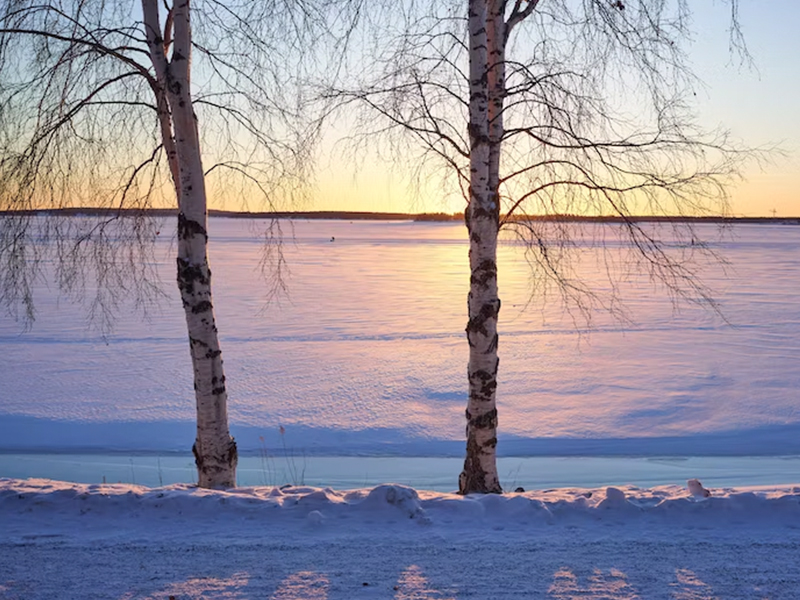

I recommend the book: The Spell of the Sensuous. It explores the loss of relation with nature
Tom, I am so happy you are reading the blog. I always appreciate your insights. I liked Abram’s Becoming Animal book also.